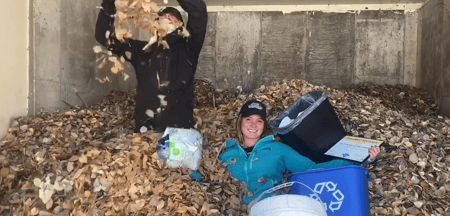Vulnerability in Vail 
Situated among Vail’s fragile upper alpine environment, Betty Ford Alpine Gardens has become one of the premier botanical gardens since its founding in 1986. Actively Green Certified since 2017, the garden emphasizes conservation and education via seed exchange events, educational campaigns, and informational tours of summer wildflowers. When the Garden was founded, the goal was to expand public awareness and appreciation of the area’s rare alpine environment and flora, provide horticultural advice to new residents, and develop Vail as a tourist destination in a way that would protect its fragility. Nearly forty years later, Betty Ford Alpine Gardens continues their original mission in new and unique ways. As strategies have evolved and changed, their call to action stays the same: Both individual and collective action are necessary to conserve Vail’s vulnerable landscapes.
Horticultural Pioneers
Picture yourself in Vail in 1988, and you’d find Betty Ford Alpine Gardens in its nearly original state. Before being renamed in honor of former first lady, Elizabeth Anne (Betty) Ford, the gardens were known as the Friends of the Alpine Garden and then Vail Alpine Garden. The Gardens were founded by a group of horticultural pioneers and devoted community members with a shared dream: a landscape designer and small nursery owner, a passionate gardener, and a mechanical engineer and World War II Veteran; Marty Jones, Helen Fritch and Bob Fritch. Soon after the trio met, they were hard at work raising money and turning soil. The Gardens were born and off to work!
First of Its Kind
To bring in visitors, tourist destinations must capitalize on what makes them unique. An individual destination's uniqueness fuels economic development, and assuming over-tourism can be avoided, helps build a place-based, unparalleled resiliency.
Vail’s uniqueness comes from its ecological abundance. Located in the largest extent of accessible alpine terrain in the contiguous 48 states, Colorado is home to the Southern Rockies’ highest peaks, ranging from 11,000 to 14,000 feet in elevation. Positioned among the Sawatch Range, Vail sits among some of the most studied alpine ecosystems in the country. With this unique positioning comes the opportunity for conservation advocacy, education, entertainment, economic development, international collaboration, horticulture, recreation, and sustainability awareness to intersect at the Betty Ford Alpine Gardens.
Although climate change was not initially within their purview, the Gardens’ founders chose to consider how the Gardens would leave a lasting impact. They established a seed collection strategy intended to facilitate the exchange of rare and unique alpine species and a database of information and photographs of all the plants in the Garden. Today, the collection of seeds has grown to over 3,000 native perennial species. As the climate changes, many plant species are becoming endangered or will likely become endangered in the future. According to current Gardens’ Operations Manager, Ellen Lorenz, collecting seeds is the Garden’s most impactful work.
Over the years, the Gardens’ conservation endeavors have expanded to include both ex-situ and in-situ conservation: Ex-situ being the indoor cultivation of each species for collection of their seeds, or seed banking; and in-situ being the study of each species in their natural setting. Both of these conservation methods being performed in tandem, ensures each species has a greater opportunity for adaptation to climate change.
In addition to this significant conservation field work, Betty Ford Alpine Gardens has also taken their expertise to paper. In collaboration with Denver Botanical Gardens, the Gardens contributed to North American Botanic Garden: Strategy for Alpine Plant Conservation, which provided a framework for the development of alpine plant conservation strategies among botanical gardens globally.
From the Gardens' early years hosting tours, events and other educational programming to its present purpose for research and conservation, Betty Ford Alpine Gardens has grown its level of impact, expanding beyond Vail to the global scientific community, and beyond.
No Fear of Getting Dirty!

“Deepen your understanding of these magical yet fragile mountain environments and consider for a moment a world in which they can no longer exist.” Words from landscape architect Sarah Chase Shaw express the evolution of Betty Ford Alpine Gardens’ mission to include the impacts of climate change on high alpine environments. To effectively address climate change and its impacts, Betty Ford Alpine Gardens has enhanced its conservation and sustainable tourism efforts. In particular, the Garden has chosen to focus on waste reduction and diversion to reduce their environmental footprint.
Analysis of the waste generated at Betty Ford Alpine Gardens between 2018 to 2021 shows an impressive increase in waste diversion rates. Although visitation to one of Vail’s top attractions was drastically reduced throughout 2020 due to the COVID-19 pandemic, the Gardens were able to consistently reduce their waste, overall, year after year.
The chart at right shows a baseline waste diversion rate of about 42% in 2018, due entirely to recycling efforts.
In 2019, this rate increased 7% with the addition of a compost waste stream contributing 4% of the total waste diverted. During this time, the Gardens participated in the Town of Vail’s Waste Diversion Challenge with other local businesses, and were awarded Cleanest Recycling for maintaining a recycling stream with the least contamination rate. The Gardens attained this award by expecting staff to properly sort their waste, and when necessary, digging through waste bins to ensure zero contamination. Betty Ford Alpine Gardens staff have no fear of getting dirty!
In 2020, an additional 11% of all waste was diverted - with an 8% increase being contributed through composting efforts (12% of total waste was composted) and a 3% increase through recycling efforts (48% of total waste was recycled).
By 2021, compost had increased another 5%; while recycling decreased a mere 4%; and waste to the landfill stayed nearly the same, decreasing only slightly by 1%.
Composting gained ground at the Alpine Gardens as volunteers and employees became enthusiastic about taking all organics, whether it was from their lunch or weeds pulled from the garden, to the compost bin. Composting also became the norm at community and member events hosted at the Alpine Gardens. Serviceware is now chosen based on its recoverability: whether it can be composted or recycled. The increased effort to compost coincides with a noticeable increase in compost diversion rate over time, and occasionally having no landfill bound waste some months.
The Alpine Gardens has succeeded in decreasing the amount of waste they send to landfill while increasing the amount they recycle and compost year over year. This is what we want to see from all local businesses and organizations, since it contributes to our Climate Action Plan for the Eagle County Community goals and encourages visitors and locals alike to adopt waste diversion practices at home.
In The Next Forty Years
Betty Ford Alpine Gardens has received extensive acclaim, not just as a botanical garden, not just for their impact on global alpine conservation, but also for their more local impact on sustainable development of tourism in Vail. By prioritizing the reduction of their environmental impact and increasing their impact as an organization, Betty Ford Alpine Gardens is contributing to a Vail that will be able to tell the story of high alpine ecology for the next forty years.






